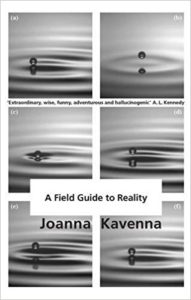
By Jonathan McCalmont
A Field Guide to Reality — Joanna Kavenna (Riverrun)
 Like most middle-class activities, book reviewing is constrained by a set of largely unspoken rules. Criticising a book for its lack of style, its poor grasp of human psychology, and its inability to provoke any emotion beyond boredom are all more-or-less acceptable lines to take but one cannot, for example, slate a book simply because an author holds their knife like a pencil or once said something horrible about you on their blog. These are not acceptable lines to take even though people probably take them more often than they’d like to admit.
Like most middle-class activities, book reviewing is constrained by a set of largely unspoken rules. Criticising a book for its lack of style, its poor grasp of human psychology, and its inability to provoke any emotion beyond boredom are all more-or-less acceptable lines to take but one cannot, for example, slate a book simply because an author holds their knife like a pencil or once said something horrible about you on their blog. These are not acceptable lines to take even though people probably take them more often than they’d like to admit.
One of the ways in which genre reviewing differs from mainstream reviewing is that genre reviewers have traditionally been willing to go after books that get their facts wrong and fail to achieve verisimilitude. It is easy to understand why mainstream reviewing tends to frown on this type of approach as questioning an author’s use of style directs discussion back towards the book while questioning an author’s grasp of how space elevators are supposed to work only ever results in people slapping their slide-rules down on the table.
I mention this as while I think there’s a lot of interesting stuff going on in Joanna Kavenna’s fourth novel, my enjoyment of the book was hampered by my initial urge to disagree with every word of it. In fact, the only thing that kept me from throwing the book across the room was a growing suspicion that I did not so much disagree with A Field Guide to Reality as agree with it far too much.
The story begins in thirteenth-century Oxford where the great and the good of medieval philosophy dine on bread and discuss the nature of reality. Rather than portraying this fledgling academic community as a place of potential and great innovation, Kavenna presents it as dark, dank, and treacherous. Outside the colleges, monks get stabbed for the contents of their pockets. Inside the colleges, monks get burned for the contents of their heads.
The urban character assassination continues as the book transports us to a present-day Oxford that is not quite our own. Indeed, while our Oxford is expensive, over-developed, clogged with tourists, and perfectly suited to the task of churning out the dead-eyed and slug-like servants of capital, Kavenna’s Oxford is much more like the real world Glastonbury in that it is hilly, rural, mist-shrouded, and filled with people who have learned to how to make a living out of talking complete shite.
The unpleasant realities of Kavenna’s Oxford are far from lost on the book’s protagonist as Eliade waits tables in an Oxford café and so spends every day drenched in the passive-aggressive condescension of Oxford dons. In fact, the only academic who treats Eliade like an actual thinking person has just up and died.
Eliade is dragged from her bed in the middle of the night by a bunch of academics insisting that she come immediately to her friend’s rooms at the college. The issue is that the college are desperate to get their hands on the manuscript to a near-mythical and potentially-lucrative work of popular non-fiction entitled A Field Guide to Reality. The problem is that while the academic’s rooms do not contain any unpublished manuscripts, they do contain a rather large box adorned with the words “For Eliade”.
This scene is one of the strongest in the book as Kavenna portrays the assembled academics in almost the exact same terms as the mist-shrouded thugs who once slit monkish throats. Once upon a time, psychopaths skulked in fog banks and shadows, now they sit at high table:
I nodded towards a pair of real flinty sticks. Folding their flinty limbs into armchairs. Sasha Petrovka dressed all in black. Black gloves pulled up to her elbows. Long black skirt, black boots. Long face, long black hair. Sharp angles. Patrick O’Donovan in generic don. You couldn’t get much more don than that. Tweed jacket, mustard scarf, burgundy cords. Such a clash of shades and tones, as if he was daring you to protest.
But this is the Winchonian Blag, did you not know, you frightful peasant?
The academics begin by trying to suggest that anything in the box belongs to the college. They do this by deploying the tools of their academic trades; Splitting hairs, offering self-servingly idiosyncratic definitions, and generally using their social status to steam-roller all opposition. Unimpressed, Eliade sticks to her guns and insists upon opening the box herself only to find that it is completely empty. Having been denied the opportunity to bully a waitress out of her worldly possessions, the academics return to tossing the room and sniping at each other in a manner as unedifying as it is ineffectual. Annoyed that her friend seems to have used his final moments to play a prank, Eliade heads to his house and discovers a series of riddles and notes that look very much like a treasure hunt designed to lead Eliade to a potentially valuable manuscript.
Some reviewers have likened this book to Sophie’s World by Jostein Gaarder as both works feature intellectual patriarchs who brutalise young women with unwanted journeys through the history of Western philosophy. The telling difference is that while Gaarder’s book is absolutely committed to the idea that pre-Socratic philosophers might have something important to tell us about the nature of the world, A Field Guide to Reality is considerably more cynical not just about academia but also about the very concept of philosophical truth.
Eliade’s initiatic journey begins with a visit to the home of an artist who is obsessed with the symbolic power of pinecones. Written with a level of intellectual coherence that is conspicuously absent from many later scenes, this section surveys the many appearances that pinecones have made in human myth and suggests profound connections between cultures that were divided both by time and space. Eliade is won over just for a second, but then her interlocutor pulls a lever and opens a trap door beneath her feet:
How could the ensuing project of the enlightenment, man as lord of nature, have any meaning at all?
‘Perfectly and beautifully, Descartes crafted a fudge,’ said Port. ‘A big fat fudge. You understand? You understand what I mean by fudge?’
He was leaning towards me. He was intent on the definition of fudge. His pinecones were glistening in the light, surrounded by swirls of illuminated dust.
‘Descartes fudged his philosophy so that he might live. And thus the pineal gland was rendered once more integral. Always integral. This thing of myth and physical embodiment. A thing both physical and immaterial. This little pineal gland, said Descartes, was where the impossible occurred, and the mind communed with the body. Immateriality and materiality. And the church wandered away, nodding its clerical heads and Descartes breathed a sigh of relief. Is not life absurd and beautiful at the same time?’
This passage reminded me of a scene from Alan Moore’s From Hell where the Masonic physician responsible for the Ripper murders drags an unsuspecting coach-driver around a series of London landmarks. As they go, the murderer explains what all of these landmarks symbolise and how they fit into a complex mythological system that demands the immediate murder and mutilation of local sex workers. Moore makes his opinion of the physician’s intellectual tour-de-force obvious by having the coach-driver vomit into his own lap: The point being that, given enough time and intelligence, humans can construct belief-systems that are beautiful, complex, and unambiguously false.
Descartes wanted to strip human knowledge back to first principles and build a system that rested on truths as inviolable and self-evident as the fact that we are things that think. Unfortunately, his fear of the church compelled him to incorporate lies and fudges that resulted in a system just as flawed and untrue as the theological systems that came before it. How can we trust philosophical thought when it begins and ends with creatures that learn to fear and grasp before they even think?
Having raised serious doubts about the aims and methods of philosophical speculation, the book glides from one hallucinatory interlude to another. Whether in confronting boat-dwelling hippies, tea-drinking cultists, waffling museum curators, or incomprehensible scientists, Eliade is subjected to page after page of resonant philosophical declamations with nary a grain of insight to be had. Kavenna’s language is complex, beautiful, and dripping with allusions to classical literature but rather than capturing truth, it conveys only a sense of bafflement and intellectual despair through passages like:
I saw the Y dust shining in the Y light. For all the sterility of the room, the Y dust swirled and shone. So beautiful, so Y. And the Y was also the Y of Osiris, and the Y of the Pope and the Y of Bacchus. And the middle prong extended until it formed a pinecone.
Of course I shivered. The pineal cone of inner light!
And:
For a long time, ages, I walked with my hands outstretched. Shadows surged, and dwindled. I roamed through emptiness until finally I blinked and hardly trusted what I saw –
The timorous glow –
The sulphur-stained city –
Shadowy old turrets and the all the memories, traces, mirages –
So I was alive, after all!
On a structural level, A Field Guide to Reality is an exquisitely clever piece of writing as Kavenna begins the book on a note of genuine anger at both the elitism of academic institutions and the absolute worthlessness that characterises much of their intellectual output. However, while these cynical notes do come together to form a thematic chord, the chord progression is only allowed to resolve itself at the very end of the novel. This means that while the protagonist is content to swallow every half-baked truth that comes her way, the reader confronts these ideas with the cynicism they deserve. Eliade may believe that she is immersing herself in oceans of beautiful complexity but the reader can quite clearly see her flapping away on the bank vomiting up copious litres of pond. The tension between the cynicism of the novel and the optimism of the book’s protagonist may or may not recall Voltaire’s Candide but it certainly makes for a tense and uncomfortable reading experience.
The novel concludes with Eliade walking away from her initiatic journey unchanged. In another beautifully cynical move, Kavenna dangles romantic opportunity before the protagonist only to whip it away at the last moment as though to reinforce the sense that our protagonist has been wasting her time by indulging in metaphysical speculation. Sorry Eliade… there ain’t no truth to be had in philosophy and no sex neither.
Readers familiar with Kavenna’s earlier works will recognise themes such as the urban alienation of Inglorious, the blurred line between truth and fiction from The Birth of Love, and the darkly satirical hatred of capitalist greed from Come to the Edge. A Field Guide to Reality marks neither her first dalliance with alternate realities nor her first engagement with the history of thought and so its position on the Clarke submissions list is absolutely beyond dispute. In fact, I would even go as far as to say that A Field Guide to Reality is one of the smarter shots across science fiction’s bows to emerge in recent years. Drenched in venom and fundamentally opposed to the genre’s founding myth that speculation promotes understanding, A Field Guide to Reality is angry, difficult, and entirely fed up with your tedious droning bullshit.
*
Jonathan McCalmont is a film critic, fan writer, and columnist for Interzone magazine. One-time Londoner and low-level academic drone, he has now surrendered to the forces of entropy and taken up residence in a wood.
>> Read Jonathan’s introduction and shortlist.
2 Comments
Pingbacks
-
[…] “On Joanna Kavenna’s A Field Guide to Reality: a review by Jonathan McCalmont” […]
-
[…] investigation of light and perception, A Field Guide to Reality by Joanna Kavenna. While Jonathan approves of its class consciousness in the form of a cynical satire of academia, Maureen is intrigued by the alt-Oxford setting and […]


